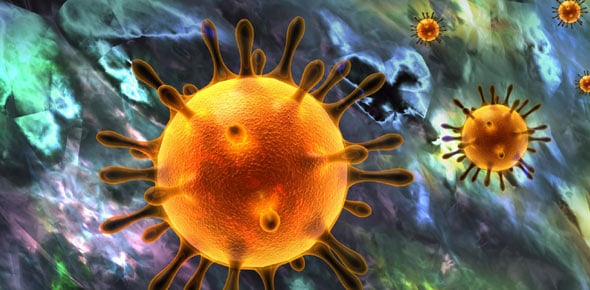Retrovirus

- 1.
What are characteristics of Retroviruses?
- A.
Can squire host genes
- B.
Can insert into the germline of a host
- C.
Can be used as a vector for foreign gene
- D.
Source of reverse transcriptase
- E.
All of the above
Correct Answer
E. All of the above -
- 2.
Retroviruses are primarily vertebrate viruses as well as insects and mollusks
- A.
True
- B.
False
Correct Answer
A. True -
- 3.
Attachment with Retroviruses requires CD4 and a co-receptor called __________
Correct Answer
chemokine
chemokine receptors - 4.
How does Retrovirus attach/fuse with cells?
- A.
Envelope protein is cleaved by cellular proteases
- B.
SV stands for Surface Virus
- C.
TM stands for Transmembrane Protein
- D.
SV binds to CCr5 and CD4
- E.
TM binds to CCR5
- F.
Fusion peptide inserts into membrane
Correct Answer(s)
A. Envelope protein is cleaved by cellular proteases
C. TM stands for Transmembrane Protein
D. SV binds to CCr5 and CD4
F. Fusion peptide inserts into membrane -
- 5.
Reverse transcription produces double stranded DNA copy from an RNA genome
- A.
True
- B.
False
Correct Answer
A. True -
- 6.
Uses 3' OH as primer for DNA synthesis
- A.
True
- B.
False
Correct Answer
B. False -
- 7.
Uses tRNA on PB as a primer
- A.
True
- B.
False
Correct Answer
A. True -
- 8.
After the primer binds to the PB on the 5' end, the 3' end of newly synthesized DNA gets extended starting at the U5 region and then....
- A.
TRNA-DNA hybrid transfers to other end of template
- B.
The R regions base pair
- C.
All RNA gets degraded
Correct Answer(s)
A. TRNA-DNA hybrid transfers to other end of template
B. The R regions base pair -
- 9.
After the 3' end is extended, all of the RNA template has been removed by RNAse H
- A.
True
- B.
False
Correct Answer
B. False -
- 10.
PP is a piece of RNA that gets left behind and is used primer for reverse transcriptase.
- A.
True
- B.
False
Correct Answer
A. True -
- 11.
The PB on each end base pair to one another and form a circular molecule, with the 3' end being extended by the reverse transcriptase until you are left with a final double stranded DNA molecule
- A.
True
- B.
False
Correct Answer
A. True -
- 12.
Why is there extra sequence added on to each end (the LTR)?
- A.
To serve as a promoter
- B.
To ensure all genes inside that region gets transcribed
- C.
To integrate into the host
Correct Answer(s)
A. To serve as a promoter
B. To ensure all genes inside that region gets transcribed -
- 13.
What is used to cut host DNA and insert the dsDNA into the cut site?
Correct Answer(s)
Integrase
Integrase protein - 14.
What is the promoter for transcription?
Correct Answer(s)
U3 - 15.
Polymerase can bind to both U3 regions
- A.
True
- B.
False
Correct Answer
A. True -
- 16.
One pre-mRNA can be made into:
- A.
Translated directly: gag & pol
- B.
Spliced: gag & pol + other proteins
- C.
Spliced: gag & pol only
- D.
Genomic RNA: packaged into virus particles
Correct Answer(s)
A. Translated directly: gag & pol
B. Spliced: gag & pol + other proteins
D. Genomic RNA: packaged into virus particles -
- 17.
A ribosomal frameshift is needed for gag expression
- A.
True
- B.
False
Correct Answer
B. False -
- 18.
The gag polyprotein contains:
- A.
MA: matrix protein
- B.
CA: capsid protein
- C.
NC: nuclecapsid protein
- D.
POL: polymerase
- E.
IN: integrase
Correct Answer(s)
A. MA: matrix protein
B. CA: capsid protein
C. NC: nuclecapsid protein -
- 19.
The pol polyprotein contains:
- A.
MA: matrix protein
- B.
CA: capsid protein
- C.
NC: nuclecapsid protein
- D.
POL: polymerase
- E.
IN: integrase
- F.
PRO: protease
Correct Answer(s)
A. MA: matrix protein
D. POL: polymerase
E. IN: integrase
F. PRO: protease -
- 20.
How is the virus released?
- A.
Budding through outer membrane
- B.
Lyses the cell
- C.
Creates a pore
Correct Answer
A. Budding through outer membrane -
Quiz Review Timeline +
Our quizzes are rigorously reviewed, monitored and continuously updated by our expert board to maintain accuracy, relevance, and timeliness.
-
Current Version
-
Jan 25, 2013Quiz Edited by
ProProfs Editorial Team -
May 09, 2011Quiz Created by
Jaedikealic
- Anatomy Quizzes
- Bio Quizzes
- Biological Evolution Quizzes
- Biology Exam Quizzes
- Biology Test Quizzes
- Cell Quizzes
- Cell Biology Quizzes
- Chapters Of Biology Quizzes
- Classical Conditioning Quizzes
- Conservation Biology Quizzes
- Enzyme Quizzes
- Fungi Quizzes
- General Biology Quizzes
- Genetics Quizzes
- Immunology Quizzes
- Macromolecule Quizzes
- Marine Biology Quizzes
- Mitosis And Meiosis Quizzes
- Molecular Biology Quizzes
- Parasitology Quizzes
- Physiology Quizzes
- Prokaryote Quizzes
- Protist And Fungi Quizzes
- Protozoa Quizzes
- Respiratory Quizzes
- Spine Quizzes
- Stem Cell Quizzes
- Taxonomy Quizzes
- Traits Quizzes
- Ultimate Biology Quizzes
- Zoology Quizzes
 Back to top
Back to top


